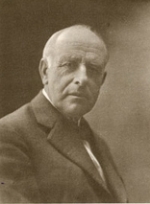U.Porto Memory
University of Porto Famous Alumni
Gonçalo Sampaio
 |
Gonçalo Sampaio 1865-1937 University lecturer and naturalist botanist |
 Gonçalo António da Silva Ferreira Sampaio was born in the parish of S. Gens de Calvos, in Póvoa de Lanhoso, on 29 March 1865.
Gonçalo António da Silva Ferreira Sampaio was born in the parish of S. Gens de Calvos, in Póvoa de Lanhoso, on 29 March 1865.
In 1885, he enrolled in the Normal School in Porto, aiming to become a primary school teacher, but eventually left and was accepted in Braga Secondary School to complete his secondary education studies.
He then enrolled in the Mathematics Course in the University of Coimbra, but later dropped out, although he passed the subjects of Superior Algebra and Analytical Geometry.
In the academic year 1890-1891, he enrolled in the Porto Polytechnic Academy, where he studied Mineral Chemistry, Botanics and Zoology, but never completed the course.
In the first year at this institution, he attended the 7th (Inorganic Chemistry, part 1) and 10th subjects (Botanics, part 1); in the second year, (1891-1892) he enrolled again in the 7th subject, and in the 8th subject (Inorganic Chemistry and Analytics, parts 1 and 2) and in the 11th subject (Zoology, part 1). In the two following years he did not enrol in any subject. In the academic year 1894-1895, he enrolled in the following subjects: 2nd (Differential Calculus), 4th (Descriptive Geometry, part 1), 6th (Physics, part 1), 8th (Organic Chemistry and Analytics, part 2), and 18th subjects (Drawing, parts 1 and 2), but he only passed the 7th, 10th and 11th subjects.
As a student, he showed a lot of talent in plant studies, and even organized a herbarium for the Botanics Professor, Manuel Amândio Gonçalves, and published his first work in this field of knowledge, entitled "Flora Vascular Portugueza. Quadro dichotomico para a determinação das famílias" (1895) (Portuguese Vascular Flora. A dichotomic table for the definition of families).
 In 1901, encouraged by Amândio Gonçalves, he was nominated assistant-naturalist in the Botanical Department at the Porto Polytechnic Academy, and in 1902 was in charge of supervising the students’ projects in Botanics.
In 1901, encouraged by Amândio Gonçalves, he was nominated assistant-naturalist in the Botanical Department at the Porto Polytechnic Academy, and in 1902 was in charge of supervising the students’ projects in Botanics.
Between 1909 and 1914, he published the "Manual da Flora Portuguesa" (Portuguese Flora: Manual), a fundamental work on national flora, and in 1910, when Amândio Gonçalves fell ill, he occupied the Botanics chair. However, this academic post was temporarily interrupted by the proclamation of the Republic, and Sampaio was forced to seek refuge in Galicia as he was a declared supporter of João Franco (a crown supporter).
 In 1912, he was appointed Botanics Professor in the recently created Faculty of Sciences of the University of Porto, and in 1913 he was nominated Head of the Botanical Department.
In 1912, he was appointed Botanics Professor in the recently created Faculty of Sciences of the University of Porto, and in 1913 he was nominated Head of the Botanical Department.
In 1919, following the attempt to restore the Monarchy in Portugal (the North Monarchy), after the death of Sidónio Pais, he was involved in the organization of the Academic Battalion and, as a result, he was made prisoner in Aljube. During the months he spent in prison, he wrote "Epítome da Flora Portuguesa" (A Synopsis on Portuguese Flora), which was never published.
After leaving prison, he returned to teaching and witnessed the transformations of the Department he used to run in the Botanical Institute.
Gonçalo Sampaio was an innovative and efficient teacher who applied histological techniques in his practical classes, and also a renowned researcher, a reputed systematist and nomenclaturist. Acting in this quality, he described about 50 new vascular plant species, edited the monograph entitled "Rubus portuguesa" (Portuguese Rubus) (1904), and prepared an important herbarium. He published a catalogue of lichens in mainland Portugal, studied the Galician lichen flora, together with Luiz Crespi, organized an exsiccation of Portuguese lichens, and described about 70 new species and a new genus novo (Carlosia). He was also dedicated to Desmidiaceae (family of fresh-water algae), identifying 5 new species.
Sampaio was also involved in defining international research rules, namely at the Luso-Spanish Congress in Porto (1921), and contacted reputed botanists of his time, for example, Júlio Augusto Henriques (1838-1928) and D. António Xavier Pereira Coutinho (1851-1939). He also collaborated, with Romualdo Gonzalez Fragoso (1862-1928), among others.
 Sampaio was a music lover, a self-taught violin player, and actively engaged in the research on folklore - he collected about 200 popular songs, edited in the "Cancioneiro Minhoto" (Minho Song-book).
Sampaio was a music lover, a self-taught violin player, and actively engaged in the research on folklore - he collected about 200 popular songs, edited in the "Cancioneiro Minhoto" (Minho Song-book).
He died in Porto, on 27 July 1937, at the age of 72, and left two manuscripts practically ready for publishing (Flora de Portugal and Catálogo dos Líquenes portugueses - Flora in Portugal and Catalogue of Portuguese Lichens). These two manuscripts were edited posthumously by Américo Pires de Lima, with the title "Flora Portuguesa" (Portuguese Flora), in 1946.
(Universidade Digital / Gestão de Informação, 2009)
Last updated: 2016-06-22 Webpage created on: 2025-06-13 16:48:31 Complaint Portal